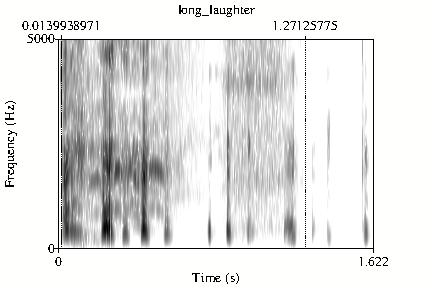Analyzing the different meanings of laughter in conversational speech
- Status
- Finished
- Type
- Master Thesis
- Announcement date
- 08 Jul 2020
- Student
- Eva Schmallegger
- Mentors
- Research Areas

Short Description
In natural conversations, much of the information exchanged we actually do without using words. One of the most common nonverbal vocalizations in conversation is laughter. For instance, in business meetings 8.6% of the vocal activities are not lexical words but laughter [1]. One can expect a even higher percentage of laughter in informal conversations between friends (as the material in mind for this master thesis [3], see Figure bellow and listen to the example). Interestingly, laughter does not occur randomly in conversation and it can convey different messages (e.g., I think this is funny, I am embarrassed, you laugh so I laugh with you, etc…).
Automatic Speech Recognition systems (ASR) and Dialogue Systems so far can only distinguish laughter from regular speech; recently first attempts have been made to automatically distinguish the different meanings of laughter [2]. Whereas some approaches try to segment laughter in syllable-like units and use these smaller units for classifying different meanings of laughter, the aim of this work is to use properties of the overall shape of laughter.
Your Task
Review of Literature
Extraction of prosodic features
Linguistic and acoustic interpretation of the results
Your Profile (recommended)
Speech Communication Laboratory or
Speech Communication 1 and 2 or
Spoken Language in Human and Computer-Human Dialogue or
Linguistic Foundations of Speech Technology
Good Programming Skills (e.g., Python)
References
[1] Laskowski, K and Burger, S. (2007). Analysis of the occurrence of laughter in meetings. Interspeech 2007, pp. 1258-1261.
[2] Tanaka, H. and Campbell, N. (2014). Classification of social laughter in natural conversational speech. Computer Speech and Language 28, pp. 314-325.
[3] Schuppler, B., Hagmueller, M., Morales-Cordovilla, J. A., Pessentheiner, H.(accepted). GRASS: the Graz corpus of Read and Spontaneous Speech.
Related Research Project:Cross-layer language modeling for conversational speech (FWF Stand-Alone Project P 32700-N)
